ISSN ONLINE(2319-8753)PRINT(2347-6710)
ISSN ONLINE(2319-8753)PRINT(2347-6710)
Mini K.1,Manjunatha B.M.2
|
| Related article at Pubmed, Scholar Google |
Visit for more related articles at International Journal of Innovative Research in Science, Engineering and Technology
Heavy mineral deposits of great commercial value along the coastal zones has created much interest in exploration and exploitation of this easily mineable wealth. Even though the mineral extraction brings huge benefits to the country, the deterioration of environment creates serious matter of concern. This study investigated the Suspended Particulate Matter (SPM), Respirable Particulate Matter (RPM), and 232Thorium concentrations in ambient air of ten locations around the mining and mineral separation activity in Manavalakurichi, southwest coast of Tamil Nadu, India, from January 2014 to June 2014. The results showed that SPM varied from 80.2 μg/m3 to 173.0 μg/m3 and RPM varied from 38.3μg/m3 to 65.12μg/m3, with maximum at IREL bus stop. Both SPM and RPM were within permissible limit of 200 μg/m3 and 100 μg/m3 respectively (National Ambient AIR Quality Standards 1994, 2009). 232Thorium ranged from 0.0003 Bq/m3 to 0.0007 Bq/m3, being far below Derived Air Concentration (DAC) Standard of 0.22 Bq/m3 as per ICRP (2000) guidelines.
Keywords |
| Monazite, placer deposits, RPM, SPM, 232 Thorium. |
INTRODUCTION |
| Indian coast of about 7500 km length is enriched with abundant natural resources including huge beach placer mineral deposits of high commercial value and global market demand. As the great Indian economist Kautilya envisaged in Arthashasthra, '' the mines are the source of treasury, from treasury comes the power of government ", mining is the second major activity next to agriculture contributing to the economy of India. At the same time, the excoriation of mineral deposits from their metallogenic provinces causes degradation in the quality of air, water, soil, eco-system etc. India is bestowed with a huge reserve of about 278 million tonnes of Ilmenite, 86 million tonnes of Garnet, 84 million tonnes of Sillimanite, 18 million tonnes of Zircon, 13 million tonnes of Rutile and 7 million tonnes of Monazite. Stil l India’s contribution is a mere 0.1% in the global market. One of the major reasons is the serious concerns about the negative impacts of mining of placer minerals from environmentally and ecologically sensitive coastal regions of occurrence. These concerns are always put forward at regional, state or federal level by intellectual groups, as well as public, creating hurdles in mining activities. It is high time to perform a comprehensive evaluation of mining activity by groups of experienced intellectuals from different fields like environmentalists, economists, industrialists, and ecologists etc. to evolve out realistic strategies for sustainable mining. |
II. RELATED WORK |
| Bagchi A.,[1] in his case studies on environmental friendly mining had investigated on various activities of mining and mineral recovery process contributing to environmental pollution and specified the management strategies to combat and remediate them. Mahendra Kumar et al.,[2] ; Polasa R.,[3] and Takafugi S. and Nakagama T.,[4] conducted studies on deterioration of human health due to air pollution, interaction between particulate air pollution and allergens enhancing allergic and airway responses etc. and had identified the various health risks associated with air pollution. Pillai P.M.B.,[5] had observed that the Naturally Occurring Radioactive Materials (NORMs) in the placer deposits are often a serious matter of concern to workers as well as public during mining and milling operations. Pillai P.M.B., and Khan A.H.,[6] in their study on radiological safety environmental surveillance during mining and milling of beach minerals and processing of Monazite has pointed out that the dry processes in mineral recovery like high tension separation, magnetic separation, air tabling may generate airborne dust containing Monazite and cause internal radiation exposure hazard on inhalation. Sateesh N. and Dr. Desai G.P.,[7] expressed their views that in India the environmental quality degradations exposing the public to serious air pollution problems are the outcome of rapid economic growth coupled with industrial development. Epidemiological studies investigating the role of ambient air pollution in public health are to be done for each specific situations, quantified and incorporated in air quality planning and policy making. Sujatha et al.,[8] investigated on Thorium lung burden in mineral separation plant workers by thoron-in-breath measurements and observed that mining and mineral separation of beach sand containing Monazite involves internal radiation exposure on inhalation of airborne particulates. Sundararajan et al.,[9] had discussed that heavy minerals found in the placer deposits are of high grade, rapidly increasing global market demand and conventional as well as high-tech applications necessitating large scale exploration and sustainable mining practices. |
| Placer Deposits and Mining |
| The placer deposits found in unconsolidated state with sediments, sand or gravel along the beds of rivers and lakes, coastal areas, beaches etc., consists of valuable heavy minerals of natural formation. Surface mining is commonly adopted for beach placer mining either by labour-intensive manual method or mechanized methods using drag lines, shovels, backhoes, front-end loaders, dredgers etc. The material is then delivered to concentration plants for mineral recovery. |
| The deposits in Manavalakurichi contains Ilmenite (about 46%), Garnet (7-14%), Rutile (2-7%), Zircon (4-6%), Sillimanite (2-3%), Monazite (1-2%) etc. The Monazite consists of about 8 to 10% of Oxide of Thorium and about 0.35% of Oxide of Uranium[10]. |
| Air Pollution due to Mining |
| Mining essentially causes land disturbances leading to the dispersion of particulate matter with size ranging from few nanometer to hundreds of microns. The dispersion of particulate in air is greatly influenced by the particle characteristics (size, shape, density etc.) as well as climatic factors (wind, humidity, temperature etc.). Air pollution is a major problem with significant health risks. SPM constitute inhalable particles up to 100μm in size resulting in nuisance, allergic manifestations, soiling of surfaces etc. Significant health risks associated with RPM of size less than 10μm includes acute respiratory diseases, allergic problems in eyes, nose and skin, asthma and headache. |
| The Monazite containing Oxides of Thorium (8-10%) and Uranium (about 0.35%) may get concentrated in airborne dust during vigorous concentration processes [11]. The longer retention time of Thorium in liver and lungs with chronic long term inhalation risks led to the identification of radioactive dust as a potentially significant source of internal exposure and resulted in DAC values for Thorium [12]. The external hazard is contributed by beta and gamma radiations emitted while the internalized alpha particles are carcinogenic even though symptoms may be delayed. Table I gives a brief definition of particle size convention adopted by International Organization for Standardization. |
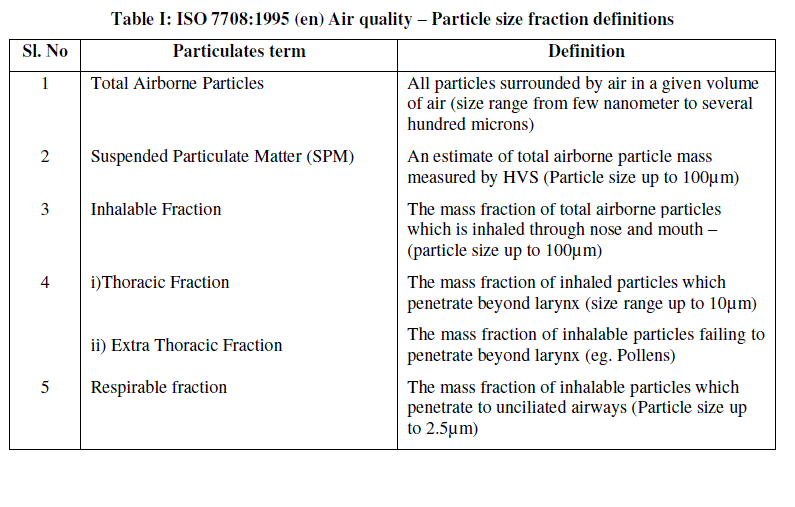 |
| National Ambient Air Quality Standards |
| India has well established and strictly implemented rules and regulations to protect water and air quality. The National Ambient Air Quality Standards (NAAQS) in Table II are periodically amended and enforced by Central Pollution Control Board (CPCB) and gives the maximum permissible limits for various air pollutants in ambient air. |
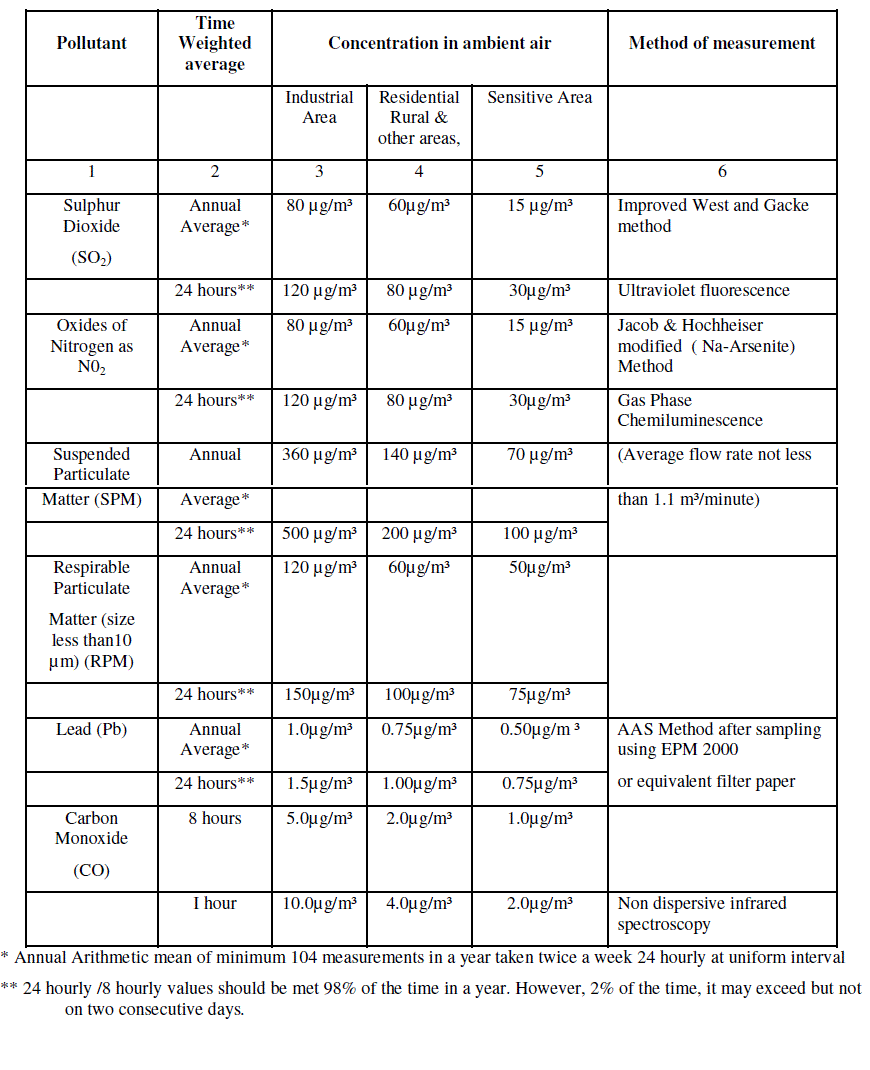 |
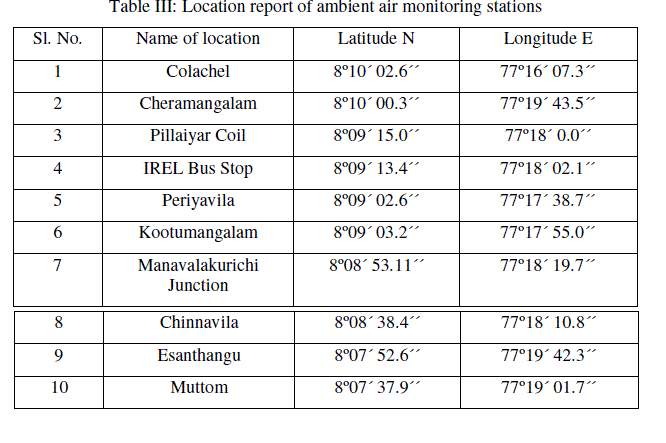 |
III. METHODOLOGY |
| Thestudy area was the coastal stretch of land from Colachel to Muttom with the ten locations selected within an average radial distance of 5 km from Mineral Separation Plant of IREL at Manavalakurichi in Kanyakumari district of Tamil Nadu, India (IS 5182- Part 14: 2005). The geology of the area was found as sedimentary formation consisting of coastal alluvium. The climatic data included average wind speed of 80 km/hr, maximum and minimum temperatures of 34.80C and 200C respectively. The maximum and minimum humidity of 96% and 41% respectively with average annual rainfall of 800mm prevails in the area. The monthly monitoring was done for 6 months from January 2014 to June 2014. Table III shows the location report of ambient air quality monitoring stations with GPS data. |
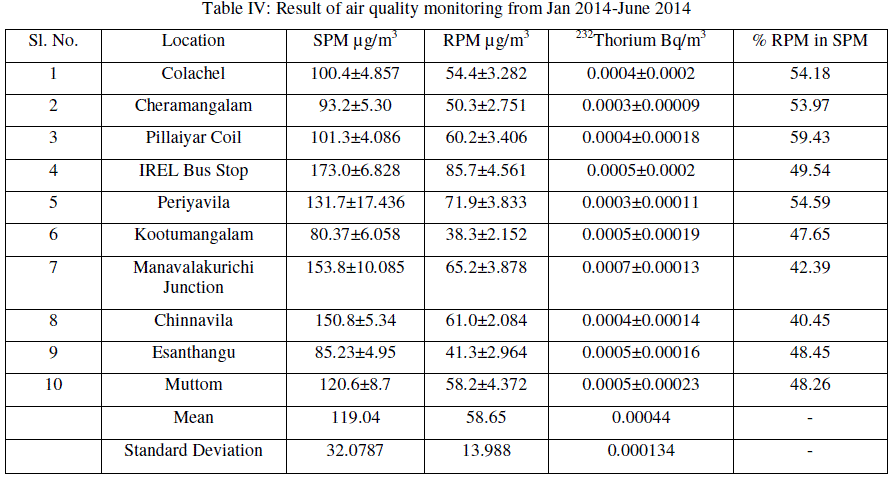 |
 |
| High Volume Air Sampler, Ecotech model AAS217BL with special grade glass micro-fibre filter, Whatmann EPM 2000 was used for 8 hour duration monitoring as per [13]. SPM and RPM were analysed gravimetrically as per [14] and [15] respectively. The air which passed at the rate of about 1.1 m3/min through the sharp cut off cyclone of the sampler caused the particles greater than 10μm size to get retained and particles less than that to pass and collect on filter paper. The filter paper was gravimetrically analysed for RPM and the SPM was obtained by aggregating the weight of RPM and that of particles retained in cut off cyclone. Then 232Thorium concentration was estimated with the help of a Nuclear Counter. |
IV. EXPERIMENTAL RESULTS |
| The SPM, RPM and 232Thorium concentrations obtained in each monthly monitoring was summarised and tabulated as in Table IV showing the mean values with standard deviations against the sampling stations. |
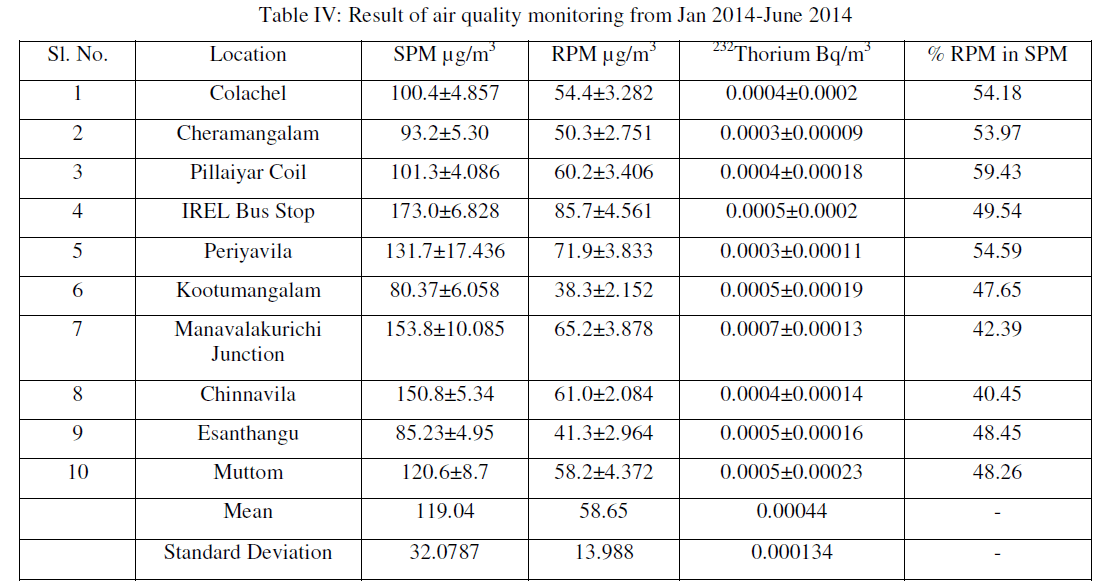 |
| The mean SPM concentration in the study area was found to be 119.04±32.0787μg/m3 and the mean RPM concentration as 58.65±13.988μg/m3. Both SPM and RPM concentrations in the ambient air of the study area were found to be below the permissible limit of 200μg/m3 and 100μg/m3 respectively as per [16]. The mean 232Th concentration of 0.00044±0.000134Bq/m3 was far below the limiting DAC standard of 0.22Bq/m3 adopted as per [17] for monitoring purposes. |
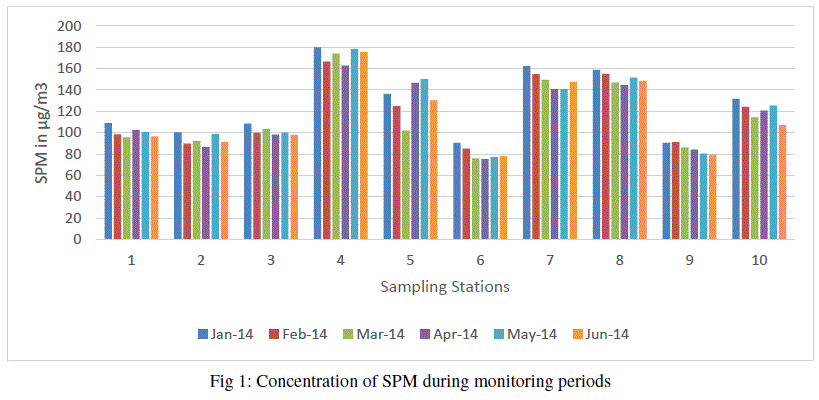 |
| The maximum concentration of SPM during the monitoring period was found to be 180.0μg/m3 at sampling station 4 in the observation of January 2014. The summer wind and high day time temperature causing rapid drying, dispersion and deposition of particulates in the airborne dust contributed to the increase in SPM above the average values. |
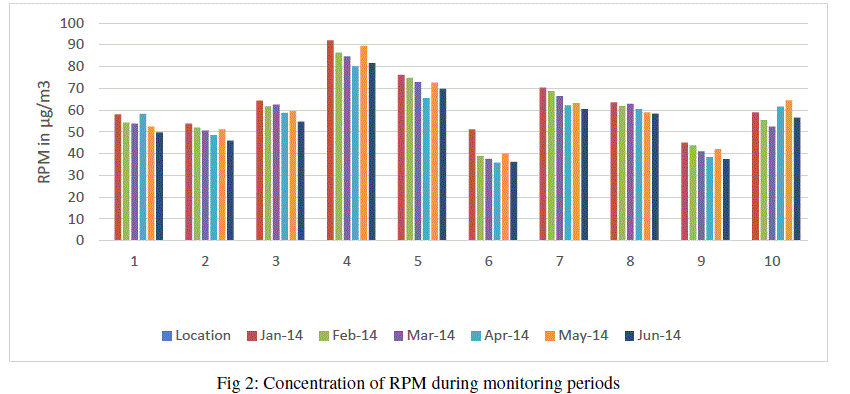 |
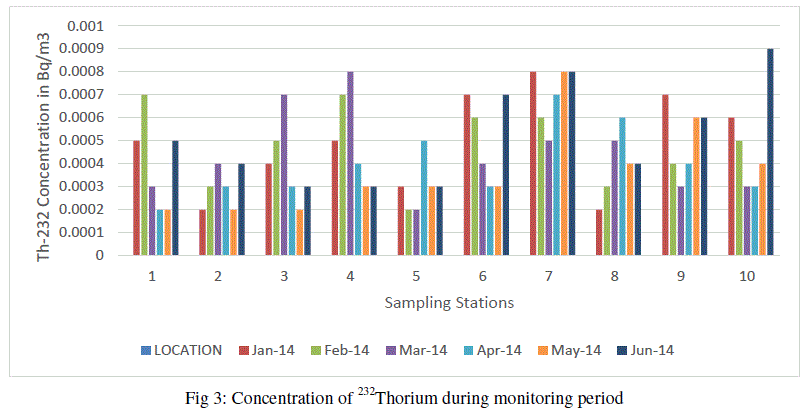 |
| The concentration of 232Thorium in the ambient air particulates during the monitoring period varied from 0.0002 Bq/m3 at sampling station 1,2,3,5 and 8 in different months observations to 0.0009Bq/m3 at sampling station 10 in June 2014 observation. Derived air activity of Thorium was found to be independent of climatic conditions or nearness to the mining and mineral recovery activity areas. |
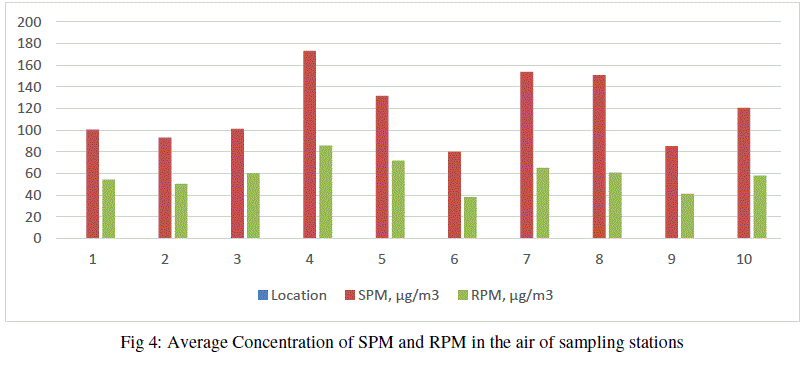 |
| The average values of SPM concentration in the sampling stations during the period of monitoring varied from 80.37±6.058μg/m3 to 173.0±6.828μg/m3. The RPM concentrations varied from 38.3±2.152μg/m3 to 85.7±4.561μg/m3 both SPM and RPM were found to be minimum at sampling station 6 and maximum at sampling station 4. The higher particulate concentration was attributed to the continuous vehicular movement of large loaded trucks transporting raw sand from mining sites to recovery plant. Maximum 232Th concentration was 0.0007±0.00013 at station 7 and minimum of 0.0003±0.00009 at station 2, which was found to be independent of particulate concentration in the ambient air. |
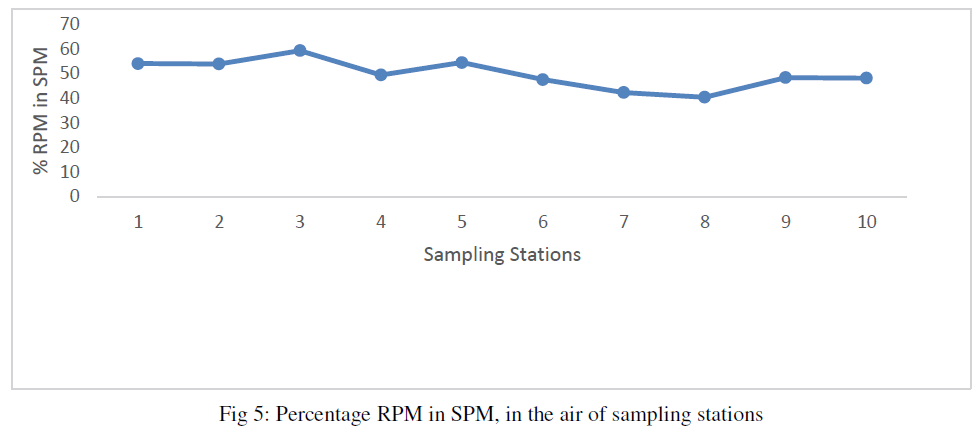 |
| The percentage of RPM in SPM in Fig 5 showed a maximum of 59.43% at sampling station 3 in contrary to the fact that the mean SPM concentration during the monitoring period was at station number 4 where the percentage of RPM was 49.54. It implied that the beach sand in the study area containing heavy minerals shows lesser dispersion tendencies in the air due to their higher densities (hence called heavy minerals). |
V. CONCLUSION |
| Estimation of SPM, RPM and 232Thorium in ambient air of 10 locations around beach placer mining activity in Manavalakurichi showed that there was no significant ambient air quality degradation due to mining and mineral recovery processes, in terms of those parameters. The SPM and RPM concentrations were within maximum permissible values as per NAAQS and 232Thorium concentrations were far below CPCB standard for DAC as per ICRP guidelines (2000). It implies the fact that Monazite possess low dispersion tendency due to its high specific gravity (about 5.25) and is in secular equilibrium with its decay products [18]. The study suggested that the dispersion of particulates in airborne dust can be reduced by completely eliminating the possibility of spillage of raw sand during transportation, timely removal of spillages enroute, imposing speed control for loaded trucks etc. The health risks due to chronic inhalation of particulate laden ambient air has to be reduced by proper methodologies |
VI. ACKNOWLEDGEMENT |
| The authors are pleased to thank the Head, IREL, Manavalakurichi, Tamil Nadu, India and its Health Physics Unit for granting permission to do the analysis of research work in their laboratory and extending valuable support whenever needed during the period of study. |
References |
|